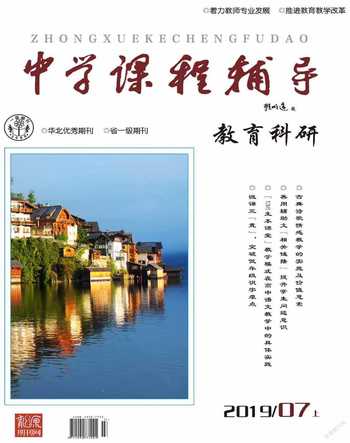核心素養背景下高中英語聽說課四維目標的設立和實現
王吉
【摘要】 ?教學目標是課堂教學的重要組成部分,是教學的出發點和落腳點。本文以高中英語選修9“Exploring Plants”為例,探討核心素養背景下高中英語聽說課四維目標的設立和實現。
【關鍵詞】 ?核心素養 英語聽說課 四維目標
【中圖分類號】 ?G633.41 ? ? ? ? ? ? ? ? ? ? ? 【文獻標識碼】 ?A 【文章編號】 ?1992-7711(2019)13-089-01
一、引言
教學目標是教學的出發點和落腳點, 是學生在課堂學習語言最終要達到的高度和水平。在課堂教學中,教師開展的課堂教學活動都必須圍繞教學目標進行。教學目標正確與否,決定著教室課堂教學效果。教學目標的設定設計多個維度,包含教師對課標、對教材、更與教師學生的個性、能力、需求等方面密切相關。教師在設定聽說教學目標時,應統觀全局,遵循科學化、系統化、具體化和動態化化的原則,確立工具性與人文性有機結合的教學目標。
依據《普通高中英語課程標準(2017年版)》,一堂英語課的教學目標可以從以下幾個方面設定:語言能力(language ability),學習能力(learning ability),思維品質(thinking ability),文化意識(cultural awareness),任何一堂英語課都應該圍繞實現教學目標而展開,下面以英語英語選修9“Exploring Plants”這一單元的聽說課為例,分析并反思英語課堂上四維目標的設立和實現。
二、四維目標的設定
1. 教材分析
本單元的話題是“Exploring plants”,學生通過閱讀課前發的handouts,介紹各種“花朵”的英文表達方式。本節課的重點是培養學生的“聽說”能力,在“聽”的基礎上獲取信息,學習語言知識,為“說”做好鋪墊。聽力原文一部分是來源于書后workbook,另一部分是來源于“在線聽力室”的一段聽力材料,內容為“My love is like a red, red rose.”
2. 學情分析
學生為珠海市某重點中學高三學生,學生語言基礎較好,思維活躍。他們求知欲強,對未知事物充滿好奇心。本班為高三理科班,男生占比為85%,女生占比為15%。基于以上特點,本節課的教學活動的設計將結合學生的特點開展,因材施教,靈活地開展課堂教學活動,培養學生聽說能力的同時,著重培養的學生思維品質和文化意識。
3. 目標的設定
對于本節課的語言能力(language ability)目標,著重培養高三學生的聽說能力,“聽”重點放在提高學生聽取主旨大意、分辨細節的能力上,“說”著重在培養學生詩歌朗讀技巧,把握英語詩句的意群、停頓,這也有利于學生更早適應廣東省高考英語聽說考試。針對本節課的學習能力(learning ability)目標,著重培養運用學習策略的能力,在課堂上通過開展pair work活動和group work活動,激發已有知識,提高合作意識。針對思維品質(thinking ability)目標,在課堂中運用教學策略,提高學生的邏輯思維、批判思維能力。對于文化意識(cultural awareness)目標,使學生能夠區別中西文化中花朵的文化內涵意義。
以下為本節課的教學目標(Teaching Objectives)
a)Language Ability:
(1) learn words and expressions related to flowers, such as petal, leaf, spring, bloom, a bonnie lass, etc.
(2) learn famous quotes and sayings related to flowers, for example, “Fragrance always remains on the hand that gives the rose.”, “There is no rose without a thorn.”, “If it’s a rose, it will bloom sooner or later.”, and so forth.
b) Learning Ability
(1) use cognitive strategies to enhance their listening skills, i.e., listening for the music genres, for details, etc.
(2) use cognitive strategies to improve speaking skills through singing the song, imitating, choral speaking…
c) Thinking ability
(1) learn to contrast, analyze, classify, criticize, etc.
(2) learn to monitor their performance in listening and speaking, etc.
d) Affect and cultural awareness
(1) learn how to cooperate with others effectively.
(2) learn to make a contrast of cultural connotations of roses in Chinese and English.
(3)become more determined and confident to English in front of their peers.
三、四維目標的實現
下面結合具體的課堂教學活動分析基于核心素養目標的實現。
(一)教學過程1: 引入(Lead-in)
T=Teacher ? ? ? ? S=Student ? ? ? Ss=Students
Step 1 Lead in: a guessing and memorizing game
Activity 1. The teacher will show the pictures very quickly and then ask the students to pinpoint the names of the flowers.
Activity 2. The teacher asks the students to match the words with the pictures.
(二)教學過程2: 聽力訓練(Listening Task)
Step 2 Listen to the song
Task 1 Focus on music
The teacher will ask the students to listen to song and try to judge the musical genre of the song by sensing the rhythm.
Task 2 Focus on comprehension
The teacher will ask the students to fill in the blanks when they listen to the song for the second time.
(三)教學過程3: 口語訓練(Speaking Task)
Step 3 Sing the song
The teacher will first find a leading singer and ask all the other students to sing the song under the guidance of the leading singer.
Step 4 Imitate (intonation, pause and liaison)
The teacher will play the recording of the poem and ask the students to imitate the reader.
Step 5 Perform choral Speaking
The teacher will ask the students to form six groups of eight students and give them 5 minutes to prepare for choral speaking.
Step 6 Explore and compare
The teacher will show the students some famous quotes or beautiful sentences in Chinese and English alike.
四、結束語及反思
高中英語教師應該仔細研讀《普通高中英語課程標準(2017年版)》對聽說技能的要求以及聽說教學目標的設計原則,正確理解并把握聽說教學目標的內涵,這樣才能最大化地幫助學生有效地使用聽說策略,激發學生的學習熱情,讓學生在課堂教學中感受學習語言、運用語言的快樂,最終達到提高學生綜合語言運用能力的目的。
[ 參 ?考 ?文 ?獻 ]
[1]程曉堂,鄭敏 .《英語學習策略》 北京:外語教學與研究出版社, 2002.
[2]戴俊霞,陳宗倫 《當代英語教學理論與實踐》 合肥:中國科學技術大學出版社, 2008.
[3]葛文山. 記憶的組塊效應與英語詞匯教學[J]. 中小學英語教學與研究,2005(7):44-47.
[4]蔣俊梅. 詞塊教學法在大學英語詞匯教學中的可行性分析[J]. 中州大學學報,2009(6):76~78.
[5]中華人民共和國教育部,《全日制普通高級中學英語教學大綱》,北
京:人民教育出版社,2001.
[6]中華人民共和國教育部,《普通高中英語課程標準(2017年
版)》,北京:人民教育出版社,2017.

